Imagine having a continuous flow of qualified talent, ready to fill any position without the scramble of reviewing resumes or conducting endless interviews. This is the essence of a talent pipeline, and it’s transforming the way organizations attract and retain top performers.
In this guide, we’ll walk businesses through the steps of how to create a talent pipeline strategy that not only brings in top talent but also reduces recruitment costs and enhances overall business performance.
Let’s explore how this process can reshape the recruitment approach of a company!
What is A Talent Pipeline?
A talent pipeline is a proactive recruitment strategy that focuses on building long-term relationships with potential candidates, rather than reacting to vacancies as they arise. Instead of starting from scratch when a role becomes available, companies maintain ongoing engagement with passive candidates who are aligned with future skills and organizational needs.
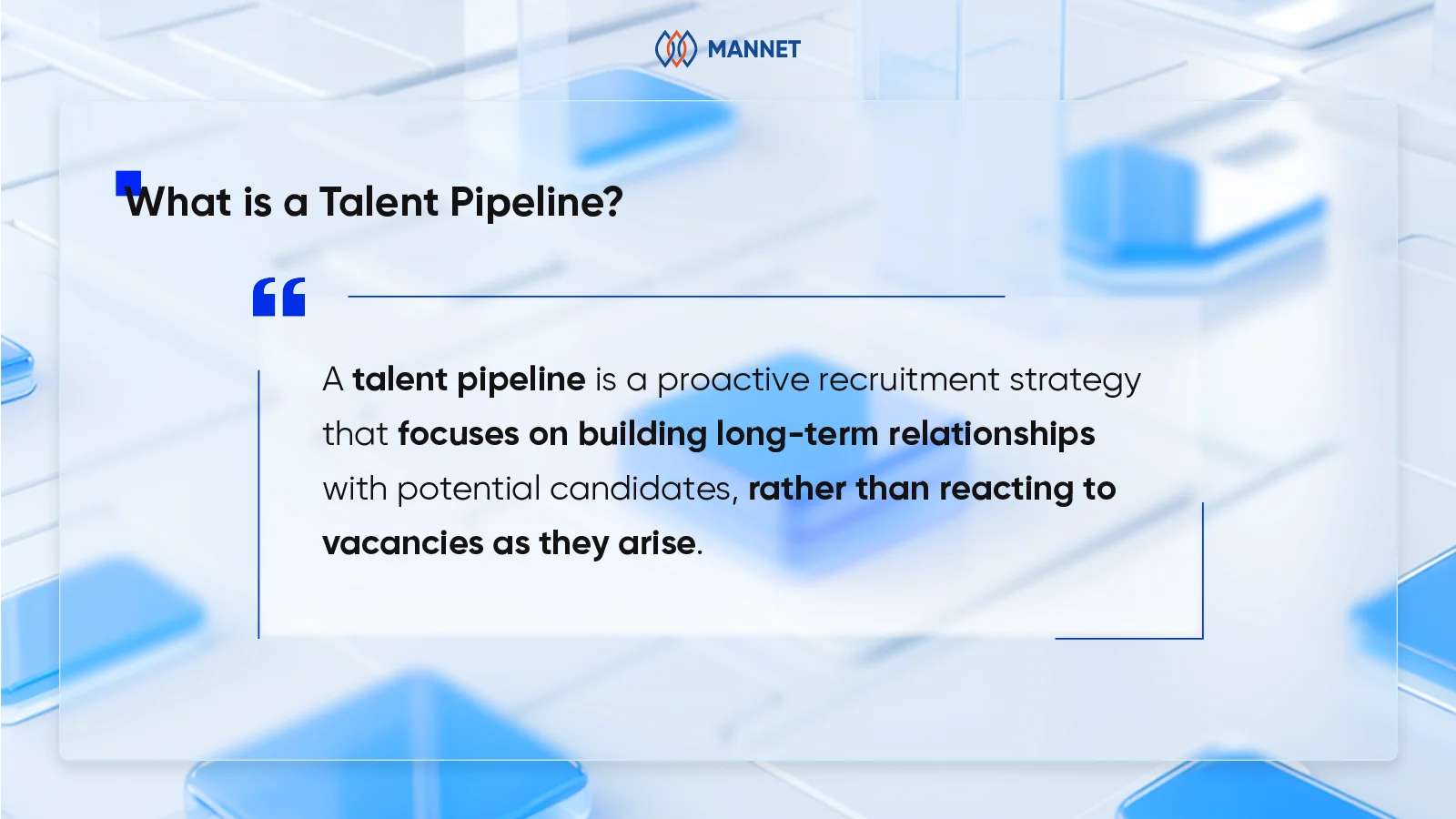
Definition of a talent pipeline
The key components of a talent pipeline include:
- Building relationships: Continuously engaging with potential candidates through various channels (e.g., networking events, social media, job fairs, etc.) to maintain a strong connection even when there’s no immediate hiring need.
- Ongoing sourcing: Actively seeking out candidates who fit the company’s future needs, not just for current vacancies.
- Candidate nurturing: Keeping potential candidates warm by providing them with relevant content, such as newsletters or industry insights, so that they stay interested in your organization over time.
- Talent pool: A group of qualified candidates who have been assessed and deemed a good fit for the organization, ready to be tapped into when positions open.
- Streamlined hiring process: With an established pipeline, companies can significantly reduce the time to fill positions, as the organization already has relationships with potential hires, and candidates are familiar with the company.
Top Benefits of a Strong Talent Pipeline
Once organizations understand how to create a talent pipeline, they can unlock a range of benefits. Let’s dive into the key advantages of having a strong talent pipeline:
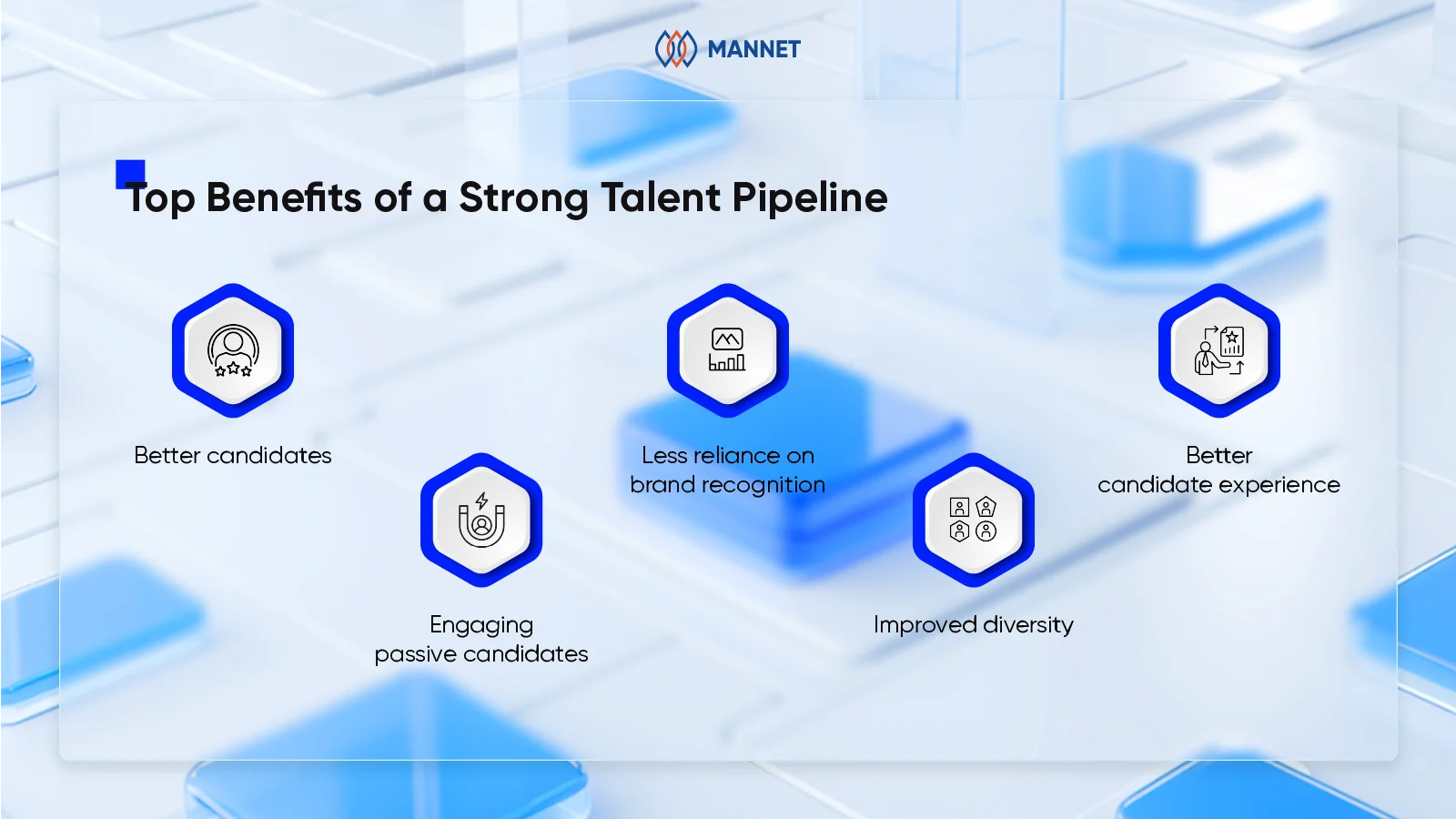
Better candidates
When companies are under pressure to fill positions quickly, they often have to compromise on the quality of candidates. A strong talent pipeline allows hiring managers more time to assess, test, and engage candidates long before a vacancy arises. This results in stronger hires who are not only technically qualified but also align with the company’s culture.
Engaging passive candidates
The best candidates are often not actively looking for a job. They may be happy in their current roles but are open to new opportunities if approached in the right way.
According to LinkedIn’s Global Talent Trends research, around 70% of the global workforce is passive, which means they won’t apply to job postings but will consider offers if approached correctly. Building and maintaining a talent pipeline guarantees that companies stay on their radar through newsletters, networking events, mentoring opportunities, or simple check-ins. When the right role becomes available, the relationship is already established.
Less reliance on brand recognition
A well-structured talent pipeline strategy helps smaller companies compete with well-known brands. Instead of relying solely on brand recognition to attract talent, organizations can leverage proactive sourcing, talent communities, and content touchpoints to build relationships over time. This is particularly important in industries where the talent pool is limited.
Improved diversity
Achieving diversity in hiring cannot be done overnight. Reactive hiring often narrows the pool, as hiring managers are under pressure to select the first available candidate. However, a talent pipeline gives recruiters the time to deliberately reach out to underrepresented groups through targeted outreach, partnerships with diversity-focused organizations, or specialized programs. This approach allows companies to build a more diverse workforce over time.
Better candidate experience
A slow and fragmented hiring process frustrates candidates. In fact, the average time-to-hire is about 41 days across industries. During this time, top candidates often accept other offers. With a pipeline, companies already have candidates in play, dramatically reducing hiring timelines. Faster hiring not only secures talent before competitors but also creates a positive candidate experience. When the process is smooth, candidates are more likely to accept offers and recommend the company to others.
5 Steps on How to Create a Talent Pipeline
For anyone wondering how to create a talent pipeline for the first time, or even just looking to improve their methodology, this 5-step process should be helpful:
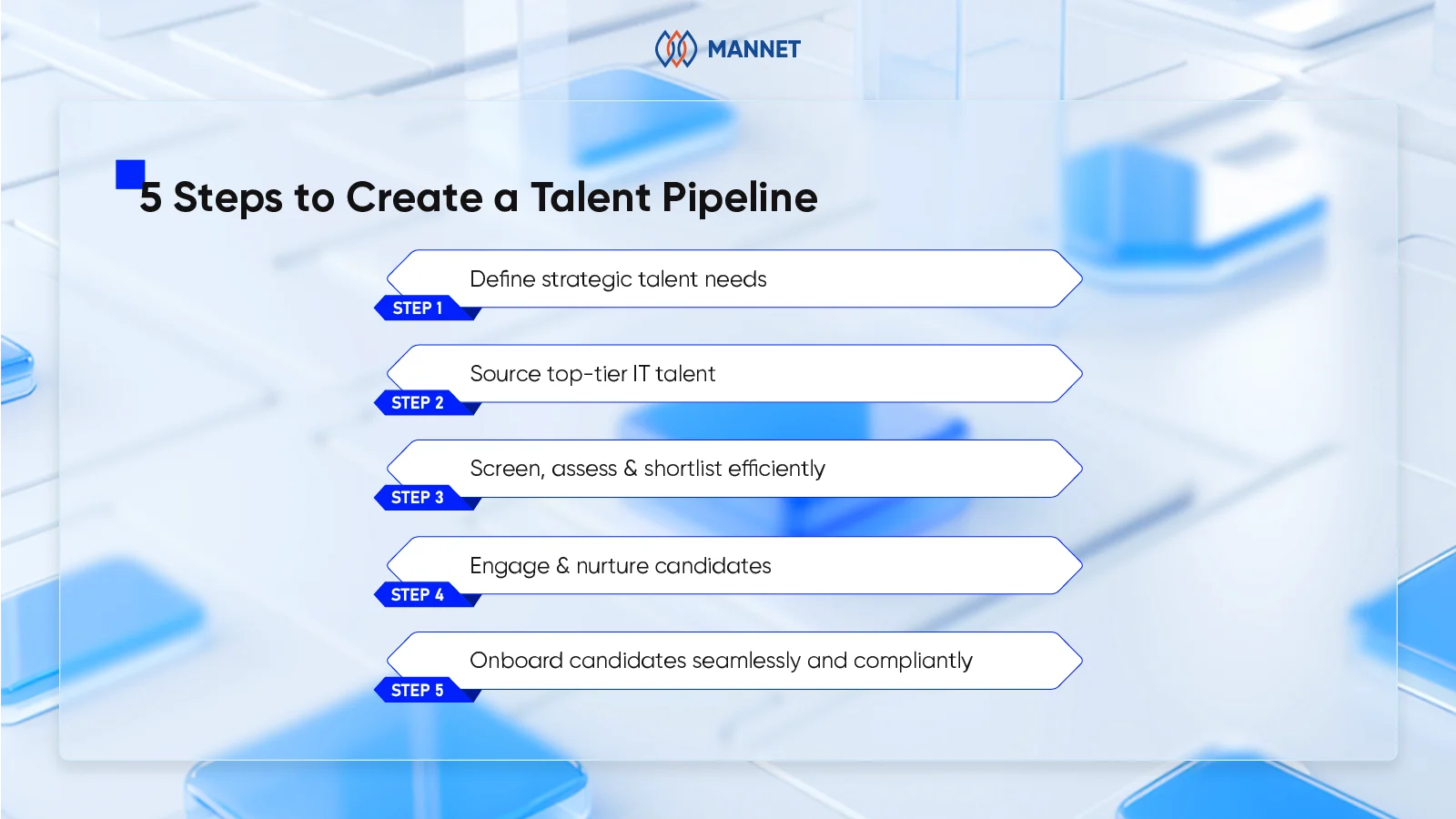
5 steps to create a talent pipeline
Step 1. Define strategic talent needs
The first step is planning. HR leaders and managers must work closely with executives to align workforce requirements with business strategy. This involves:
- Identifying mission-critical roles that could impact operations if left unfilled;
- Forecasting demand created by new markets, expansions, or regulatory changes;
- Mapping current workforce skills and spotting gaps that will widen in the future.
For example, a healthcare organization anticipating an aging population may prioritize building a pipeline of geriatric specialists. A bank investing in digital platforms may focus on cybersecurity and data privacy roles.
Mistake to avoid: Focusing only on filling immediate vacancies. A talent pipeline is about planning for the future, not just addressing today’s staffing needs.
Step 2. Source top-tier IT talent
A strong talent pipeline taps into a variety of sourcing channels:
- Professional communities (industry associations, conferences, forums).
- Education partnerships (universities, vocational schools, and certification programs).
- Employee referrals (trusted, cost-effective, high-retention).
- Global markets (outsourcing destinations, emerging hubs with growing workforces).
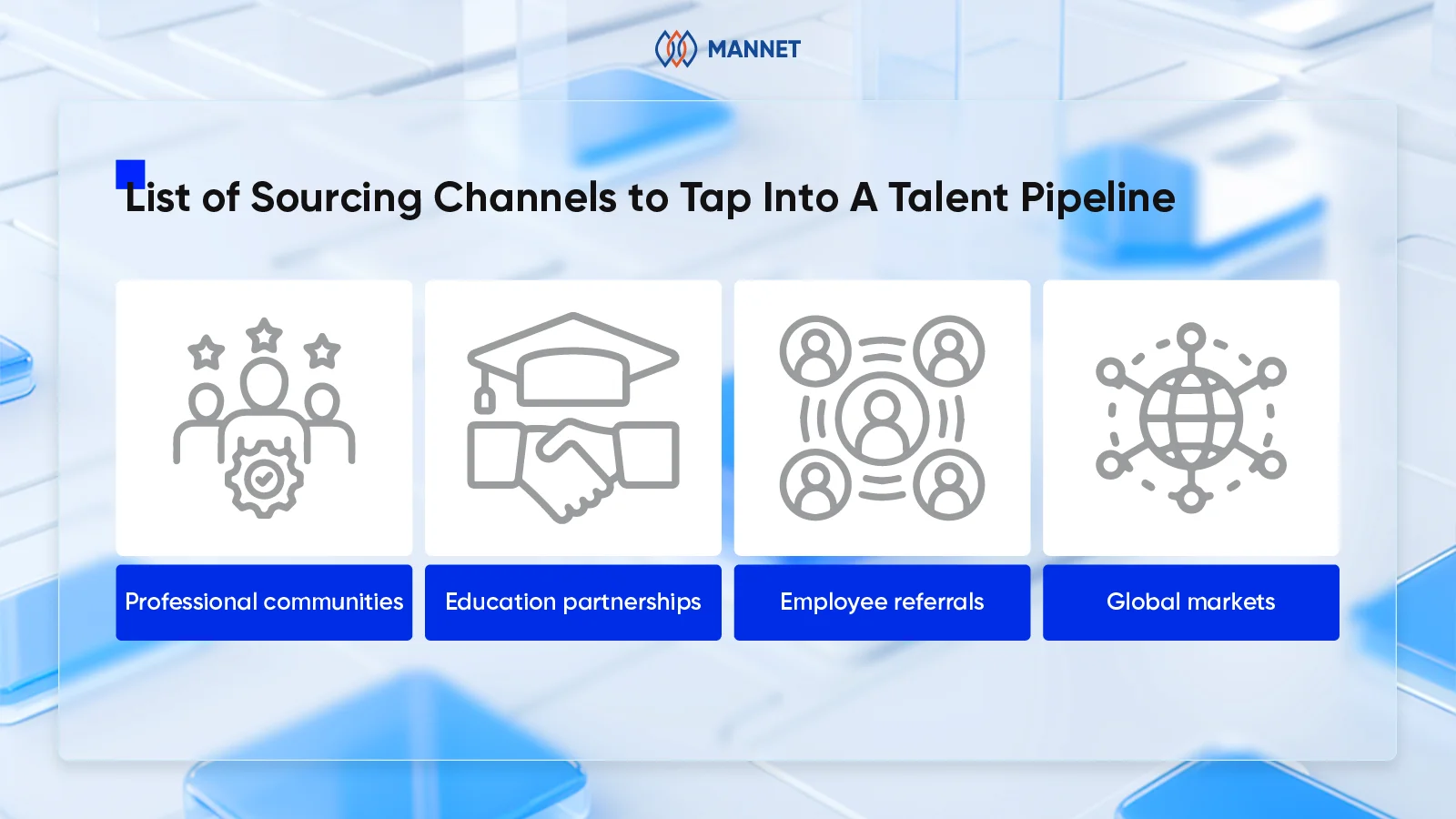
Sourcing channels for a talent pipeline
By broadening sourcing strategies, companies can reach candidates others may overlook. For instance, an IT firm could build ties with coding bootcamps, while a hospital might partner with nursing schools.
Mistake to avoid: Over-reliance on job boards, which only attract active candidates.
Step 3. Screen, assess & shortlist efficiently
Candidates should be evaluated and segmented by readiness level: immediate, near-term, and long-term. Effective assessments include:
- Competency-based interviews;
- Work simulations (e.g., coding tasks, financial case studies, medical scenarios);
- Standardized scoring rubrics to ensure fairness and consistency.
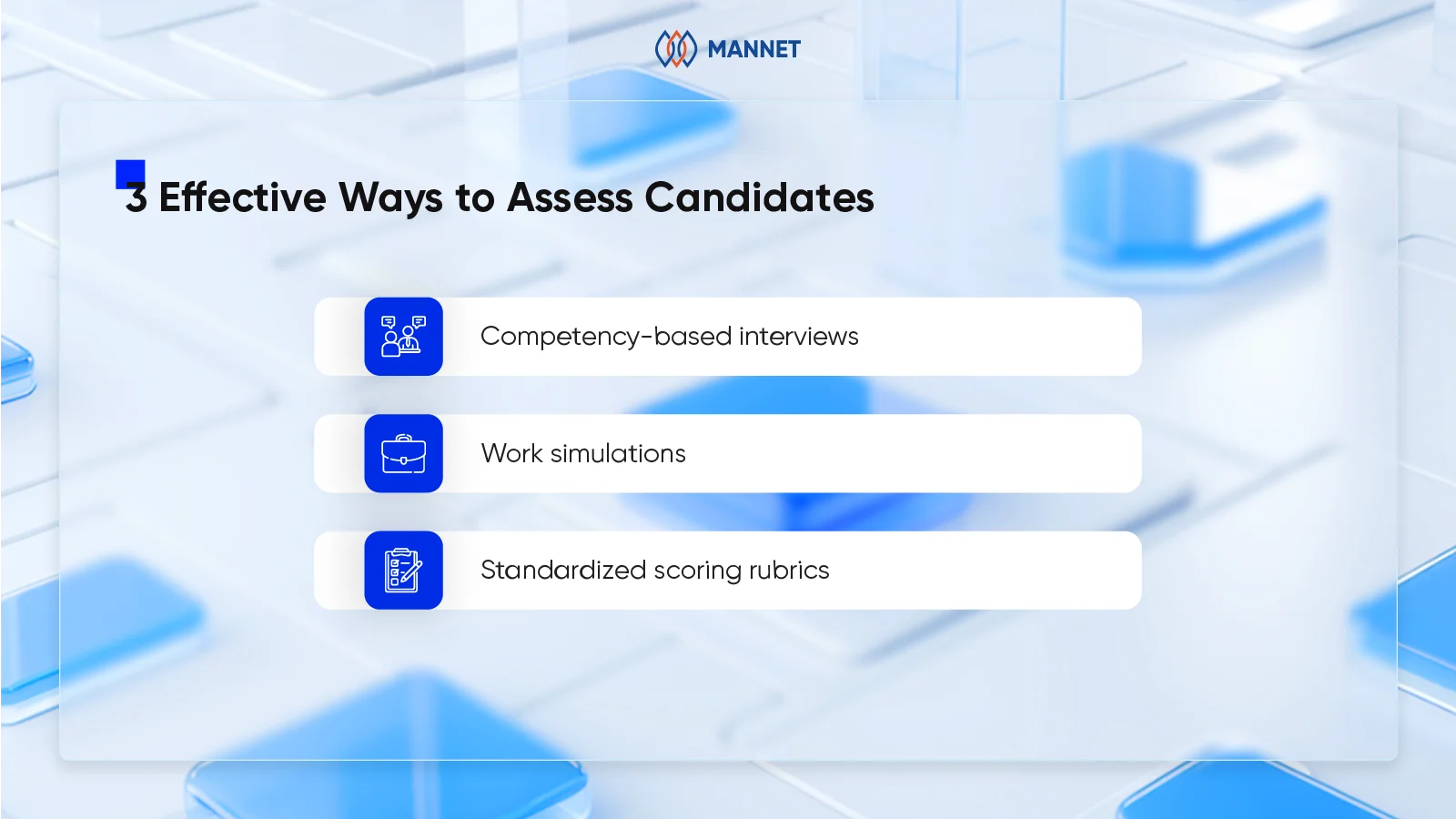
This preparation significantly reduces time-to-hire and helps reduce recruitment costs. Industry data shows that cutting just one week off the hiring process can save organizations around $4,000 per role in recruiting expenses.
Mistake to avoid: Using unstructured interviews or inconsistent evaluation criteria, which make pipelines unreliable.
Step 4. Engage & nurture candidates
Talent pipelines only work if candidates stay interested. This is where talent pipeline management plays a critical role. Recruiters must maintain ongoing communication, providing value to candidates even if no job is currently available.
Best practices include:
- Sharing company updates, project milestones, or success stories;
- Inviting candidates to webinars, workshops, or tech talks;
- Offering mentorship or networking opportunities;
- Sending periodic check-ins to maintain relationships.
This ongoing engagement keeps candidates interested, so when the right opportunity arises, they are more likely to respond positively.
Step 5. Onboard candidates seamlessly and compliantly
The final stage of steps to create a talent pipeline is to ensure that onboarding is smooth, compliant, and welcoming. This is particularly important in IT industry, where projects often involve sensitive data, global regulations, and tight deadlines.
An effective onboarding process includes:
- Clear documentation of policies, tools, and workflows;
- Security and compliance training, especially for data protection;
- Structured mentorship to accelerate productivity.
By wrapping up the process with efficient onboarding, companies can not only fill positions faster but also improve talent retention over the long term.
FAQs About How to Create a Talent Pipeline
- What is talent pipeline management?
Talent pipeline management is the process of identifying, nurturing, and overseeing a group of talented individuals for current or future positions within an organization. It involves creating strategies and processes that proactively attract, engage, and develop potential candidates to meet the company’s talent needs, both now and in the future.
- How can I measure the effectiveness of my talent pipeline?
The effectiveness of a talent pipeline can be gauged using metrics such as time-to-fill, quality of hires, offer acceptance rates, retention rates, and candidate satisfaction. Additionally, feedback from key stakeholders offers valuable insights. Regularly assessing these metrics allows you to optimize the pipeline and make informed, data-driven decisions for continuous improvement.
- What are some best practices for talent pipeline development?
Best practices for developing a talent pipeline include proactively sourcing and attracting talent, building strong relationships with potential candidates, and ensuring a positive candidate experience. It’s also important to leverage technology for candidate engagement and automation, align talent development programs with pipeline needs, and regularly assess and refine the pipeline based on feedback and data.
A Summary of How to Create a Talent Pipeline
In conclusion, focusing on how to create a talent pipeline is vital for companies that want to stay ahead in the competitive recruitment landscape. By defining talent needs, sourcing candidates from a variety of channels, keeping candidates engaged, and creating smooth onboarding, businesses can build a sustainable pipeline that supports both current and future growth.
But having a pipeline in place is just one part of the equation. The real value comes from managing it effectively and adapting it to meet your evolving needs. ManNet helps businesses at every step, including HR consultation and set-up to create the right processes and infrastructure for seamless talent management.
If you’re ready to take the guesswork out of hiring and build a pipeline that actually works, let’s talk.




